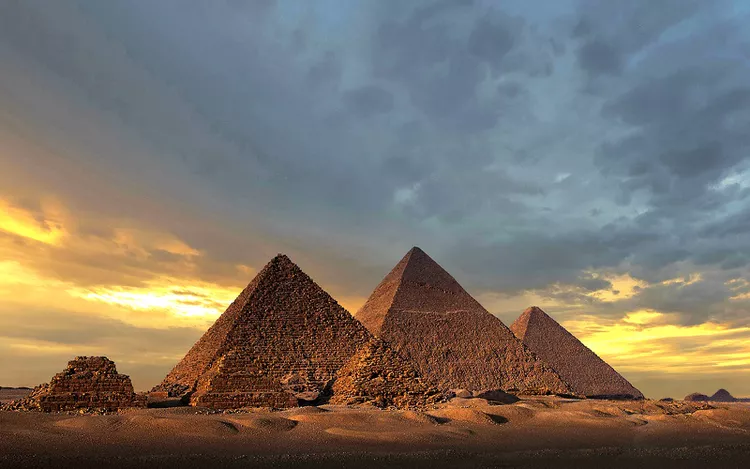Summary
The Mystery of the Great Pyramids
No matter how much we discover about the famed Great Pyramids of Giza in Egypt, there always seems to be an air of mystery surrounding these structures. Constructed roughly 4,500 years ago, these massive relics of the Old Kingdom era have survived seemingly everything.
The sheer mass of the pyramids alone is staggering — the largest one stands at 481 feet high and is made up of 2.3 million stone blocks. To this day, scientists continue to speculate about the exact construction methods used by Egyptians to build these ancient architectural wonders. So far, the most commonly agreed upon theory centers around thousands of workers using wet sand as a lubricant to move the large stones they mined from a nearby quarry on sleds across the desert. Evidence also suggests ramps may have then been used to move the stones into place, though it’s still not clear how such heavy pieces made it up to the highest sections, especially at such steep angles.
The Construction and Labor Force
Because Egyptian Pharaohs believed they would become gods in the afterlife, they created these pyramids as ornate tombs filled with everything they would need to thrive in the next world after death. Production of the first pyramid was started by Pharaoh Khufu around 2550 B.C. His son, Pharaoh Khafre built the second, slightly smaller pyramid around 2520 B.C., as well as the enigmatic limestone Sphinx that is thought to stand guard over this tomb. The third temple was built in 2490 B.C. by Pharaoh Menkaure, and is significantly smaller than the first two structures, but features a more intricate interior temple.
It is said that these stunning structures hold the secrets of the ancient Egyptian pharaohs. While scientists have been able to discover much about the different rooms and chambers within these pyramids, there are still questions left unanswered, especially with the recent discovery of secret passageways and a mysterious void within the Great Pyramid of Giza.
Historical Significance and Surviving Wonders
The Great Pyramid of Giza is the last standing ‘wonder’ of the Seven Wonders of the Ancient World.
The Seven Wonders of the Ancient World are as follows: The Great Pyramid of Giza, the Hanging Gardens of Babylon, the Temple of Artemis at Ephesus, the Statue of Zeus at Olympia, the Mausoleum at Halicarnassus, the Colossus of Rhodes, and the Lighthouse of Alexandria. Six of these ancient structures were destroyed either by natural causes like earthquakes or by human plundering — except for the Great Pyramid of Giza. This structure has survived a lot.
The Great Pyramid of Giza was the tallest man-made structure on earth for 3,871 years.
From its time of construction until 1311, when the Lincoln Cathedral in England was completed, the Great Pyramid stood taller than any other man-made structure across the globe. Today, the Burj Khalifa in Dubai is the world’s tallest man-made structure, standing at 2,722 feet.
Theories Surrounding the Pyramids
It’s thought that as few as 20,000 or as many as 100,000 workers were involved in the construction of the pyramids.
This assumption, made by historians and scientists, is based on two ideas: the first being that ancient Greek historian Herodotus claimed that construction took 20 years and 100,000 men, which is believable because these agricultural workers were likely only building when the Nile River flooded, leaving less work to be done in the fields and more hands ready for the pyramid. However, archeologists later found evidence in the 20th century that as few as 20,000 workers could have been permanently (rather than seasonally) building the Great Pyramid.
In the 12th century, Kurdish ruler al-Malek al-Aziz Othman ben Yusuf attempted to destroy one of the pyramids.
This attempted destruction was unsuccessful, as the task was just too big (no kidding), proving to be incredibly expensive and time-consuming. Menkaure’s pyramid suffered a deep gash but is otherwise intact to this day.
The Orion Correlation Theory
Introduced in 1983 by Robert Bauval, this theory makes the claim that the three Great Pyramids of Giza are positioned in alignment with the three main stars of the Orion’s Belt constellation — and that this orientation was intentional. While it seems possible, this theory has received a good amount of criticism and rebuttal.
Gaze into the secrets of history and explore more about these ancient architectural feats.




